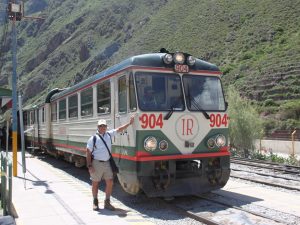One of our long-held dreams was to visit both Machu Picchu and the Galapagos Islands, and, after almost a year of research and planning, we finally chose Overseas Adventure Travel for our trip. We started our trip on Saturday by driving a short distance south to Miami’s Airport and flying the 5-hour trip to Lima, the capital of Peru. There we were met by our first OAT Representative, Cesar, who collected us up for the short bus trip to our hotel, The Jose Antonio.

In the morning, Julie and I walked the 4 blocks to the Pacific Coast to get a coffee at Starbucks, and to enjoy the great vistas and views afforded us on the bluffs overlooking their Pacific Coast highway and the morning surfing crowd. After breakfast, back at the hotel, we gathered our group of 13, (5 couples and 3 singles), with Cesar for introductions and questions and answers, and then began our facilitated adventure with a short bus ride to the historic center of town where we learned of much of the history of the country of Peru. For lunch, we were back to a restaurant on the coast where we were treated to the “national” alcoholic drink, a Pisco Sour, a buffet of local foods, and cultural dancing by professional dancers.
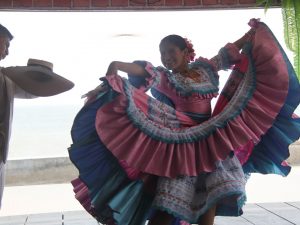
After lunch, we were off to an Inca Archeological Museum that captured artifacts and recovered tombs from the Inca civilization. Since it was Sunday afternoon, we visited Saint Martin’s Square, and then the main square in the center of town, which was fronted by The Presidential Palace, and The Bishop’s Palace, and was full of people visiting churches, listening to music and enjoying the beautiful weather.
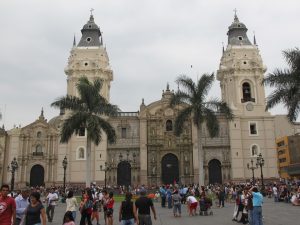
We walked to tour the active Saint Francis Monastery and Convent, including the catacombs, before returning to the hotel. The Church and Monastery were consecrated in 1673 and completed in 1774, built in the Spanish Baroque style, and is listed as a World Heritage Site as part of historic Lima. Although Cusco was the historic capital of the Incan Empire, Francisco Pizarro founded Lima as the new capital in 1535 after conquering the Incans, and a Spanish Colonial city was created. That night was our “Welcome Dinner” where we all got to know each other better before our travels inland tomorrow.
Monday morning, we arose early and caught a Lantum Airline flight from Lima to the historic Inca capital city of Cusco. Cusco sits at 11,150’ altitude, and one could definitely tell that the air was thinner from the sea level we had just left. At the Cusco airport, we boarded a touring bus and started the trip to the city of Urubamba, within the Sacred Valley. Along the way, we traveled through the town of Chinchero, our trip’s highest point, where we stopped for a “healing ceremony” with a local medicine man. He assembled a variety of items to represent all aspects of “life” and then burned them, blessed each of us, giving “thanks” to the great mountains surrounding us, and then would bury the ash remains.
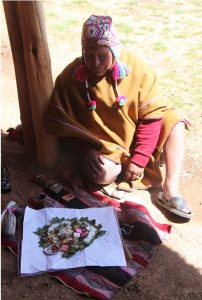
Following this, we participated in a traditional weaving demonstration starting with Alpaca wool, involving brushing, spinning, coloring and weaving of the wool to make beautiful clothes.
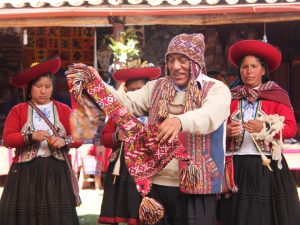
From there, we continued down into the Sacred Valley, but with a short stop to meet a local roadside farmer with a very old steer-pulled plow. The Sacred Valley was lush with fruit trees and crops that provide food for much of Peru and for its export. All along the way, the hillsides were terraced by ancient Incas, and we passed many remnant historic grain store-houses strategically placed high on the slopes. In Urubamba, (down in the valley at elevation 9,420’), we entered the enclosed Hotel Villa Urubamba, a set of cabins scattered across a beautiful, lush set of gardens with hundreds of types of blooming flowers, stone walkways and flowing water. That night we ate at the hotel, completely filling their small but very nice dining room.
Tuesday, after breakfast at the hotel, we took a day to visit and sightsee the local town. First, we visited a modest home of a local single mother with 3 daughters, who would be making us lunch that day. She demonstrated the killing and preparation of a guinea pig, a traditional, celebratory dish in Peru. In their country, guinea pigs are raised for meat, much like chicken are in most places. When one of our travel companions asked “Why would you eat our pets?” the Peruvians responded with “Why would you pet our food?”! She killed it quickly, removed the fur after a quick dip in boiling water, gutted and cleaned it, and then rubbed it with spices and oils, before stuffing it with herbs, and putting it into the oven to cook.

Meanwhile, we left to take the bus a short way down the valley to the town of Ollantaytambo, the entry way to Machu Picchu, since there are no roads that travel to the lost Incan City. The town includes an Inca archaeological site at an altitude of 9,160’ which we ascended. During the Inca Empire, Ollantaytambo was the royal estate of Incan Emperor, who built the town and a ceremonial center. At the time of the Spanish conquest of Peru it served as a stronghold for the Inca resistance, and, today, it is one of the most common starting points for hiking the Inca Trail, or catching the train there.
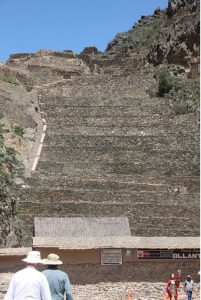
On the way there, we went to a local bar where we played a game tossing “coins” at a small table with slots and holes that carried value, and we tasted the local “hooch”, a corn-beer called “chichi”, historically drunken by the locals. From here, we left for the local market to purchase side-dish items for lunch. Cesar provided each person with a piece of paper on which was written the Spanish name of a local ingredient, (e.g. chocio = corn), and we were each sent off with a 2 Soles limit (~$0.60 USD) to find, negotiate and purchase the ingredient. The local market vendors were very helpful, and everyone completed the challenge within 10-15 minutes. Then we conversed with a local supplier of coco leaves, the local “drug” of choice to deal with altitude and sicknesses of all kinds!
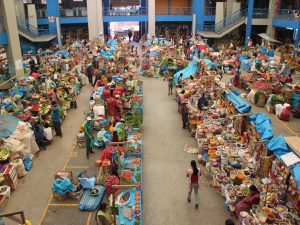
From the market, we all got into tuk-tuks, (a small 3-wheel taxi), for a short ride to a local Chapel of the Lord of Torrechayoc, where a huge cross was once left and the church was subsequently built on-top-of it. Like most churches in this country, everything is only covered in gold-leaf, as most of the solid gold was taken by the Spaniards. Finally, we returned to our host’s house for lunch, helped prepare homemade tortillas, and celebrated with her and her 3 daughters a wonderful meal or guinea pig, chicken, potatoes, tortillas, squash, and salad with roasted peach for desert. After thanking our hosts, we traveled to the home and shop of local artist, Pablo Seminarios. This region provides inspiration to many artists who make their home here. Pablo’s works are on display in Chicago and at the Smithsonian in Washington, D.C., and he discussed with us the evolution in his work and his inspirations, while walking us through his workshop and gallery.

After a brief stop at the hotel, we assembled for a short ride to dinner, hosted by another artist, Oscar, at his home/restaurant, Wallpa Wasi. He specialized in clay-oven rotisserie chicken, which was spectacular! After dinner, he took us for a tour of his house where his collectables, and some of his and his wife’s art, are proudly on display.
Tomorrow we would go on to Machu Picchu!
